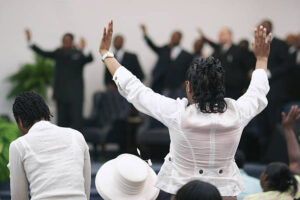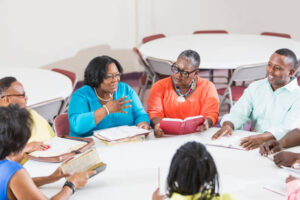The Problem
According to the Brookings Institution and other sources, the wealth of the average African American is ten times less than the wealth of the average white American [1]. Furthermore, indicators suggest that the disparity is widening, instead of narrowing. After decades of discussion, research and attempts, little progress has been made to minimize this disparity. While attending a community gathering at the local ministerial alliance in Oklahoma City, it was reported that the majority of the residents who are black rent where they live as opposed to owning their own homes. This suggests that wealth is being transferred to the owner of the property, instead of increasing the wealth of the majority of the citizens of the community. As an African American leader serving the African American community, I sought a plan of action to provide a remedy to the problem.
Context
This project was implemented in northeast Oklahoma City through Quayle United Methodist Church where I have served as senior pastor for nearly four years. The northeast part of town is primarily African American and possesses less wealth compared to other sections of the city. The church is middle class and is a historically black church. This church was founded in 1890 and is named for a white bishop who gave money toward the church’s initial down payment. This outreach-oriented church seeks ways to embrace the community in a holistic manner.
The research process offered a varied approach through academic books and articles and by conducting interviews with local financial leaders, entrepreneurs, church members and community residents.
Intervention
The intervention of five sessions was offered through the Quayle Church and to the church’s online presence. Each session involved a presentation of a scriptural passage, church stewardship and an encouragement to take a faithful step toward economic development. The goal was to sensitize the people to the nature of the problem within the community, to inspire a plan for each individual and to develop a plan for the church to impact the community toward economic development.
Impactful Interviews
One entrepreneur indicated that the only way to minimize this gap is through entrepreneurship. This will allow persons to use their gifts, to generate income, to become self-reliant and to live into self- determination of their financial future.
According to a financial leader, African Americans save money at higher rates than any other ethnic group, but they are hesitant to invest these savings. This suggests that there is wealth that needs to be invested to create more. This lack of trust in the financial system is evident with a lack of investing. Entrepreneurship allows a person to monitor their investment in something they readily understand.
Claud Anderson suggests that the history of African Americans has caused this group to see other African Americans as competition and less likely to aid each other compared to other ethnic groups. The African American dollar leaves the black community the quickest as compared to other groups [2]. A Maryland couple was discriminated against with the appraisal process of their home being valued as significantly less valuable with black family pictures hanging on the walls as compared to when the same home was appraised with white family member pictures [3].
Impact
While the intervention was primarily offered to members of the community, the problem also indirectly affects the potential ministry of the local church. A video I developed offers more ramifications for the black United Methodist Church [4]. Shattering the Stained Glass Window: Addressing Racism in the Church with Elvyn Hamilton – YouTube
The key scripture for this project is taken from Jeremiah 29:1-7 which speaks to the plight of Israel being taken form their land and forced to live in Babylon. Instead of being allowed to leave, God encouraged them to bless their community. The themes that emerged were reinvesting in the community, being good stewards of what they had, homeownership, self-determination and not relying on handouts.
Quayle Church sits on seven acres of land which possesses a large sanctuary, an education wing and a large fellowship hall (the old sanctuary). The property also has two houses, a greenhouse and two parking lots. The church has the vision to develop a business incubator. This will allow local residents space to start new businesses. The greenhouse grows food that is sold along with some being given to those in need. This venture is designed to connect further to the neighborhood, to promote entrepreneurship and to generate an income stream for the church.
The participants in the sessions were encouraged toward legacy giving allowing them to pass on generational wealth. The goal is to develop an annual financial empowerment conference.
Reimagining Tulsa (In, to, by and for the community)
Oklahoma has a model of economic development that served the black community well. Tragically, it was destroyed within a few days during the Tulsa Race Massacre just over 100 years ago. Due to segregation, the Greenwood Community of Tulsa was able to prosper with the moniker bestowed of “Black Wall Street”. Black leaders developed businesses that kept the wealth within the community [5]. This prosperous community has the potential to serve as an intentional model that is in, to, by and for the community.
[1] McIntosh, K. (2020, February 27). Examining the Black-white wealth gap. Brookings. Retrieved September 27, 2022, from https://www.brookings.edu/blog/up-front/2020/02/27/examining-the-black-white-wealth-gap/amp/
[2] Anderson, C. (2001). In PowerNomics®: The National Plan to Empower Black America (pp. 26–30). essay, PowerNomics Corp. of America.
[3] Gamble, J., & Langmaid, V. (2022, August 19). Black couple sues after they say home valuation rises nearly $300,000 when shown by White colleague. CNN. Retrieved September 22, 2023, from https://www.cnn.com/2022/08/19/us/black-couple-home-appraisal-lawsuit-reaj/index.html
[4] YouTube. (2021, October 20). Shattering the stained glass window: Addressing racism in the church with Elvyn Hamilton. YouTube. Retrieved April 14, 2023, from https://www.youtube.com/watch?v=k7BYh4v7H-Y
[5] Parshina-kottas, Y., Singhvi, A., & Audra. (2021, May 24). What the Tulsa Race Massacre destroyed. The New York Times. Retrieved April 14, 2023, from https://www.nytimes.com/interactive/2021/05/24/us/tulsa-race-massacre.html




